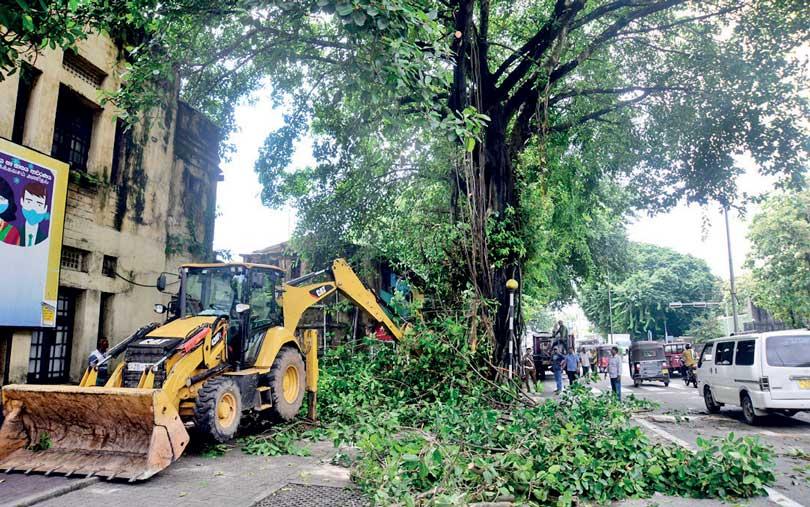11 Oct 2023 - {{hitsCtrl.values.hits}}

With a tree falling on a bus and causing many deaths and injuries to commuters who were seated inside, the Colombo Municipal Council has initiated a drive to remove trees- in many parts of Colombo- which could be a threat to pedestrians (pix by Kushan Pathiraja)
“ In Colombo we observe that there is a fairly good vegetation cover similar to a better planned city. The downside of tree-lined roads is that it could pose a risk to pedestrians and those travelling in vehicles, but this is largely a maintenance issue”
 When a tree toppled over a bus, heading towards Deniyaya from Colombo last week in Colpetty, immediate action was taken to remove trees which were a threat to pedestrians. The tragedy claimed the lives of five individuals while several others are still receiving treatment. The Colombo Municipal Council (CMC), which oversees the maintenance of Colombo’s urban infrastructure, took immediate steps to remove such trees by the roadside. So far around 20 trees have been removed from Colombo city limits; these include 6 trees at Viharamaha Devi Park, trees that have fallen down at the BMICH premises and several trees down Union Place, Denzil Kobbekaduwa Mawatha and Isipathana Mawatha.
When a tree toppled over a bus, heading towards Deniyaya from Colombo last week in Colpetty, immediate action was taken to remove trees which were a threat to pedestrians. The tragedy claimed the lives of five individuals while several others are still receiving treatment. The Colombo Municipal Council (CMC), which oversees the maintenance of Colombo’s urban infrastructure, took immediate steps to remove such trees by the roadside. So far around 20 trees have been removed from Colombo city limits; these include 6 trees at Viharamaha Devi Park, trees that have fallen down at the BMICH premises and several trees down Union Place, Denzil Kobbekaduwa Mawatha and Isipathana Mawatha.
Reactive approaches
Following the incident in Colpetty, State Defence Minister Premitha Bandara Tennakoon issued a directive advising the Disaster Management Centre and the National Building Research Organisation to collaborate with the Central Environmental Authority, Road Development Authority, Colombo Municipal Council and many other stakeholders to remove trees which are at risk of falling to minimise the threat on people.
One of the allegations made was regarding the tree scanner machine which was purchased back in 2015 at a cost of Rs. 7.4 million. This machine which can be used to scan larger trees is reportedly malfunctioning and is lying idle. The Lands and Environmental Development Division coming under the administration of the Colombo Municipal Council (CMC) oversees the maintenance of the urban environment. Following the Colpetty incident CMC officials removed several larger trees along Horton Place, Thurstan Road and several other places in Colombo. When inquired, Deputy Director Engineering (Environmental Development) Tharanga Gunaweera said that they would not be removing trees without obtaining the required expertise from experts. “The trees need to be identified one by one and we need the assistance of botanists, horticulturists and other experts in this task. We then need to decide upon which trees need to be treated, which ones should be removed, the process that needs to be followed and the due procedures,” said Gunaweera.
Responding to a query on the removal of trees in several places in Colombo Gunaweera said that the trees removed down Thurstan Road for instance were leaning towards the roadside. “We observed cracks on the pavement from where the roots have emerged. These are warning signs that a tree could be a possible threat to road users. Thereafter we decide whether the tree should be removed or treated,” said Gunaweera.
She said that the removal of other trees will be implemented after a series of meetings with the experts and that the programme will commence this week. However, Gunaweera denied claims regarding the tree scanner machine stating that it is very much in operation. “But we need someone with the technical knowledge to operate the machine. This vacancy still has to be filled, but the procedure is underway to recruit a suitable individual,” she added.
Speaking to the Daily Mirror, National Building Research Organisation Chairman Dr. Asiri Karunawardena said that it is the responsibility of the CMC to remove trees that exist within the Colombo city limits. “But we are ready to assist them if they require additional support. The tasks will be dedicated to the relevant stakeholders at a meeting scheduled to be held today (October 11). We are planning to carry out these activities with the relevant experts. In fact, prior to the monsoon several larger trees were cut down with the intervention of the Disaster Management Centre. This meeting has been scheduled to reactivate these activities,” said Dr. Karunawardena.
From a scientific point of view tree-lined roads reduce the heat island effect –a heat island is an urban area which is significantly warmer than its surrounding rural areas due to human activities. “This improves the comfort of humans as these trees provide them with shade and a cooling effect,” said Prof. Devaka Weerakoon, Head, Department of Zoology and Environmental Sciences at the University of Colombo. “When the heat island effect increases there are more greenhouse gas emissions and as a result people have to use air conditioners, fans etc., to keep them cool. Tree-lined roads also prevent the heating up of road surfaces. In addition it prevents encroachments. Therefore it is always encouraged to grow trees by the roadside.”
“But sometimes the roots will be damaged or birds may build nests on the trees,” added Prof. Weerakoon. “In Colombo we observe that there is a fairly good vegetation cover similar to a better planned city. The downside of tree-lined roads is that it could pose a risk to pedestrians and those traveling in vehicles, but this is largely a maintenance issue. We always look at the isolated issue, but it is important to maintain the road surface, ensure that the drains are cleaned prior to rains while also covering deeper drains with concrete slabs so that people will not face unexpected accidents. Therefore we need a maintenance schedule and the trees on either side of the road should be maintained regularly,” explained Prof. Weerakoon.
Prof. Weerakoon further said that it’s important to monitor trees because during the rainy season trees absorb water and the branches get heavier. “Therefore if a tree is too old there is a tendency for the tree to fall down. It is also important to check if the trunk and roots are decaying, whether there are any fungal attacks or whether people have deliberately damaged the trunk, so that the tree would eventually topple,” he warned.
He said that the removal of trees should be the last resort. “The branches can be lobbied, clippings can be attached to keep the tree upright, but if the risk of falling is greater then the tree can be removed. But there has to be a plan. It is not enough to be responding as and when an incident happens. The threat is continuous and therefore there needs to be a regular maintenance in place. In fact what is required is a long-term plan to retain the trees in Colombo,” he concluded.
09 Jan 2025 21 minute ago
09 Jan 2025 2 hours ago
09 Jan 2025 2 hours ago
09 Jan 2025 3 hours ago
09 Jan 2025 3 hours ago